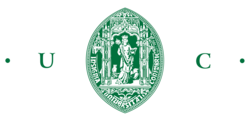
Back Universidat de Coimbra AN جامعة قلمرية Arabic جامعة كويمبرا ARZ Koimbra Universiteti Azerbaijani کویمبرا بیلیمیوردو AZB Univérsitas Coimbra BAN Каімбрскі ўніверсітэт Byelorussian Университет на Коимбра Bulgarian Universitat de Coïmbra Catalan Univerzita Coimbra Czech
Universidade de Coimbra | |
 University of Coimbra seal | |
| Latin: Universitas Conimbrigensis | |
| Type | Public research university |
|---|---|
| Established | 1290 |
| Rector | Amílcar Falcão |
Academic staff | 2,179[1] |
Administrative staff | 1,357[1] |
| Students | 28,182 (2022)[1] |
| Undergraduates | 9,896[1] |
| Postgraduates | 11,180[1] |
| 3,372[1] | |
| Location | , Portugal 40°12′27″N 8°25′35″W / 40.2074°N 8.4265°W |
| Campus | Urban/College Town |
| Students' union | Associação Académica de Coimbra (AAC) |
| Colours |
|
| Affiliations | |
| Website | uc.pt |
| Official name | University of Coimbra – Alta and Sofia |
| Type | Cultural |
| Criteria | ii, iv, vi |
| Designated | 2013 (37th session) |
| Reference no. | 1387 |
| Region | Europe and North America |
The University of Coimbra (UC; Portuguese: Universidade de Coimbra, pronounced [univɨɾsiˈðaðɨ ðɨ kuˈĩbɾɐ]) is a public research university in Coimbra, Portugal. First established in Lisbon in 1290, it went through a number of relocations until moving permanently to Coimbra in 1537. The university is among the oldest universities in continuous operation in the world, the oldest in Portugal, and played an influential role in the development of higher education in the Portuguese-speaking world.[2] In 2013, UNESCO declared the university a World Heritage Site, noting its architecture, unique culture and traditions, and historical role.[2]
The contemporary university is organized into eight faculties, granting bachelor's (licenciado), master's (mestre) and doctorate (doutor) degrees in nearly all major fields. It lends its name to the Coimbra Group of European research universities founded in 1985, of which it was a founding member. Enrolling over 25,000 students, more than 15% of whom are international, it is one of Portugal's most cosmopolitan universities.[3][4]
Coimbra's alumni over the centuries include Portugal's national poet Luís de Camões,[5] the mathematician Pedro Nunes,[6] many statesmen, prime ministers and presidents of Portugal, and Nobel Prize laureate António Egaz Moniz.[7]
- ^ a b c d e f "Facts & Figures". uc.pt. Retrieved 10 August 2022.
- ^ a b "University of Coimbra – Alta and Sofia". UNESCO World Heritage Centre. UNESCO World Heritage. Retrieved 24 March 2021.
- ^ "University of Coimbra". Times Higher Education (THE). 20 January 2021. Retrieved 24 March 2021.
- ^ "Shanghai Ranking-Universities". www.shanghairanking.com. Retrieved 13 July 2021.
- ^ "Luís de Camões". www.parlamento.pt (in European Portuguese). Retrieved 24 October 2023.
- ^ "Ciência em Portugal - Personagens". cvc.instituto-camoes.pt. Retrieved 24 October 2023.
- ^ "Prof. Egas Moniz – O Nobel Português de Medicina e Fisiologia". Faculdade de Medicina da Universidade de Lisboa (in European Portuguese). Retrieved 24 October 2023.